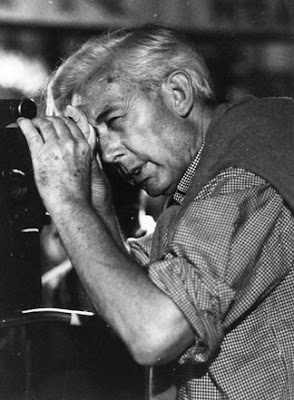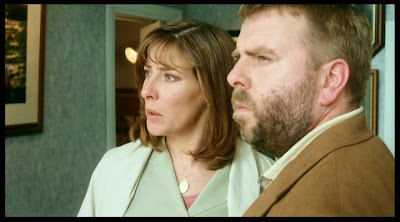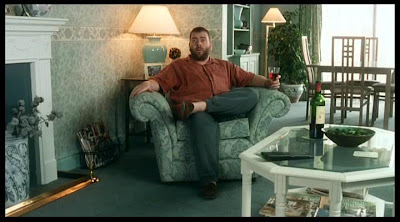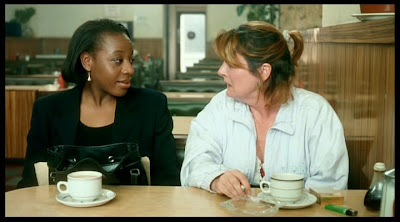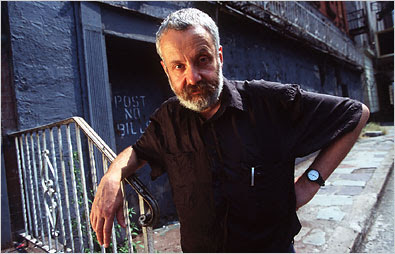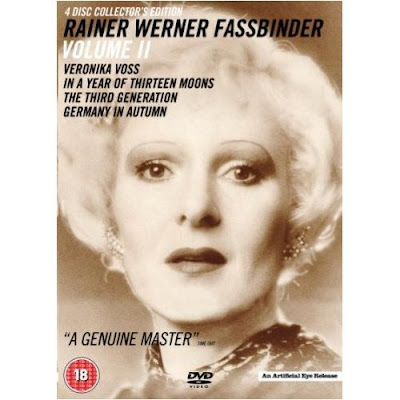
VERONIKA VOSS
A film by Rainer Werner Fassbinder
Year: 1982
Country :Germany
Run time ; 104 minutes
German with English sub titles
7th December 2008; 5.45 pm
Ashwin hospital Auditorium
http://konangalfilmsociety.blogspot.com/
Call : 9443039630
 VERONIKA VOSS was the next-to-last film made by Rainer Werner Fassbinder, who died on June 10, 1982 in Munich on account of a fatal combination of drugs and alcohol. It tells a story of a German actress, famous in the 1940s, who tried to revive her flagging career with alcohol and drugs, and fell into the hands of a sadistic woman doctor who provided the drugs as a means of controlling rich patients. The film is based on the life of Sybille Schmitz, "the German Garbo," who starred in many glossy postwar West German films before becoming addicted to drugs and killing herself in the late 1950s.
VERONIKA VOSS was the next-to-last film made by Rainer Werner Fassbinder, who died on June 10, 1982 in Munich on account of a fatal combination of drugs and alcohol. It tells a story of a German actress, famous in the 1940s, who tried to revive her flagging career with alcohol and drugs, and fell into the hands of a sadistic woman doctor who provided the drugs as a means of controlling rich patients. The film is based on the life of Sybille Schmitz, "the German Garbo," who starred in many glossy postwar West German films before becoming addicted to drugs and killing herself in the late 1950s.
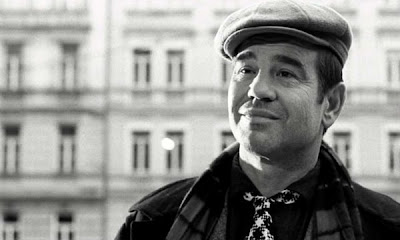 VERONIKA VOSS is the third film in his trilogy about the West German "economic miracle" of the 1950s and 1960s; the other two films were THE MARRIAGE OF MARIA BRAUN and LOLA.
VERONIKA VOSS is the third film in his trilogy about the West German "economic miracle" of the 1950s and 1960s; the other two films were THE MARRIAGE OF MARIA BRAUN and LOLA.
If MARIA BRAUN made its heroine into a symbol of Germany pulling itself together after the end of the war, and LOLA was about the conflict between corruption and duty, VERONIKA VOSS seems to be about Germany's lingering fascination with the images of the 1930s, with the carefully cultivated aesthetic of decadence, domination, perversion, and sinister sexuality.A film by Rainer Werner Fassbinder
Year: 1982
Country :Germany
Run time ; 104 minutes
German with English sub titles
7th December 2008; 5.45 pm
Ashwin hospital Auditorium
http://konangalfilmsociety.blogspot.com/
Call : 9443039630
 VERONIKA VOSS was the next-to-last film made by Rainer Werner Fassbinder, who died on June 10, 1982 in Munich on account of a fatal combination of drugs and alcohol. It tells a story of a German actress, famous in the 1940s, who tried to revive her flagging career with alcohol and drugs, and fell into the hands of a sadistic woman doctor who provided the drugs as a means of controlling rich patients. The film is based on the life of Sybille Schmitz, "the German Garbo," who starred in many glossy postwar West German films before becoming addicted to drugs and killing herself in the late 1950s.
VERONIKA VOSS was the next-to-last film made by Rainer Werner Fassbinder, who died on June 10, 1982 in Munich on account of a fatal combination of drugs and alcohol. It tells a story of a German actress, famous in the 1940s, who tried to revive her flagging career with alcohol and drugs, and fell into the hands of a sadistic woman doctor who provided the drugs as a means of controlling rich patients. The film is based on the life of Sybille Schmitz, "the German Garbo," who starred in many glossy postwar West German films before becoming addicted to drugs and killing herself in the late 1950s. VERONIKA VOSS is the third film in his trilogy about the West German "economic miracle" of the 1950s and 1960s; the other two films were THE MARRIAGE OF MARIA BRAUN and LOLA.
VERONIKA VOSS is the third film in his trilogy about the West German "economic miracle" of the 1950s and 1960s; the other two films were THE MARRIAGE OF MARIA BRAUN and LOLA.
 It gives us a heroine who, at one time in her career, stood for the sort of sophisticated, chic sexuality associated with Marlene Dietrich. But by the time we meet Veronika Voss, she can't even pull herself together to do a tiny scene in a movie. She seeks comfort from strangers. She is hopelessly addicted to drugs, and is the captive of a psychiatrist who enjoys having a fallen star around the office.
It gives us a heroine who, at one time in her career, stood for the sort of sophisticated, chic sexuality associated with Marlene Dietrich. But by the time we meet Veronika Voss, she can't even pull herself together to do a tiny scene in a movie. She seeks comfort from strangers. She is hopelessly addicted to drugs, and is the captive of a psychiatrist who enjoys having a fallen star around the office.
Fassbinder's visual style is the perfect match for this subject. He shoots in the unusual combination of wide screen and black and white, filling his frame with objects: clothes, jewelry, furniture, paintings, statues, potted palms, kitsch. This is a movie of Veronika Voss's life as Veronika might have pictured it in one of her own nightmares.
 The elaborate camera moves and the great attention to decor are just right for the performances., which come in two styles: stylized and ordinary. Veronika Voss is elegant even in her degradation, but she is surrounded here by plainer folks like Robert, the sportswriter she picks up in a cafe. There are times during the movie when we can almost see everyday, ordinary postwar Germany picking its way distastefully through the smelly rubble of pre-war decadence.
The elaborate camera moves and the great attention to decor are just right for the performances., which come in two styles: stylized and ordinary. Veronika Voss is elegant even in her degradation, but she is surrounded here by plainer folks like Robert, the sportswriter she picks up in a cafe. There are times during the movie when we can almost see everyday, ordinary postwar Germany picking its way distastefully through the smelly rubble of pre-war decadence.

Rainer Werner Fassbinder
Controversial and prolific German director and playwright, who attracted attention with his politically committed and disillusioned stage plays and films. Fassbinder's central theme was the political and social corruption of postwar Germany.
Few filmmakers lived their private lives more publicly than Rainer Werner Fassbinder (1945-1982), and few have had those lives so relentlessly linked to their artistic output. Starting at age 21, this self-created enfant terrible made over 40 films in 15 years along with numerous plays and TV dramas.

Born in 1945 to a bourgeois Munich family, Fassbinder rebelled early.He shifted his aesthetic allegiance from German culture, in which he was well versed, to Hollywood, often seeing as many as 15 features a week. His own films would borrow equally from classic and modern European sources from Thomas Mann to Artaud to Brecht, and the melodramatics of Hollywood genre pictures. To this mix he would add extensive theatrical experience gained through association with groups like the “Anti-Theater,” where he would learn writing, directing,
This homely, overweight gay rebel generated the fiercest loyalties among his troupe, and repaid them by eliciting a gallery of brilliant performances from actors who would never, with rare exceptions like Hanna Schygulla, repeat what they achieved under his tutelage.
Fassbinder ruthlessly attacked both German bourgeois society and the larger limitations of humanity; his films detail the desperate yearning for love and freedom and the many ways in which society, and the individual, thwarts it. His main characters tend to be naifs, either male or female, who must be rudely, sometimes murderously disabused of their romantic illusions, which threaten the social and philosophical status quo.
This prodigiously inventive artist distilled the best elements of his sources — Brechtian theatrics, Artaud, the Hollywood studio look, classical narrative, and a gay sensibility that wasn't ghettoized — into a body of work that continues to enlighten and disturb.
There is no other director whose work constitutes the history of a (now defunct) country, West Germany, in personal everyday termsFassbinder was that rarity - a truly (and repeatedly) dangerous director.
Fast living and fast working Fassbinder died of drug overdose in Munich, at the age of 36, on June 10, 1982. His death marked symbolically the end of the most experimental period of the German cinema since the 1920s.














